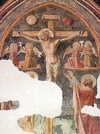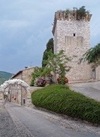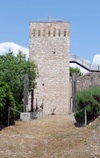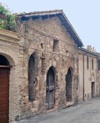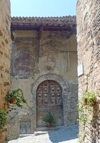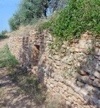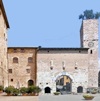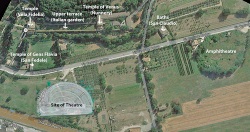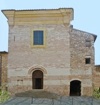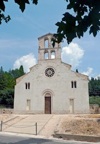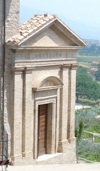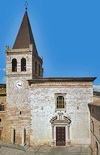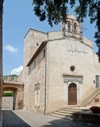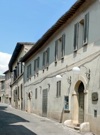Cappella Tega (14th century)
This chapel of Confraternita dei Disciplinati di Sant’ Anna, a confraternity that was first documented in 1362. It contains important frescoes (1461), which are attributed to Nicolò di Liberatore, l' Alunno and Pietro di Giovanni Mazzaforte. The confraternity was suppressed in 1571, and the chapel was later put to secular use. The frescoes were rediscovered in 1911 by the then owner, Pietro Tega (for whom the chapel is now named) and it was restored in 1970.
Chiesa Tonda (1517-39)
The Commune confiscated this site from the rebel Vico di Chiatti in 1373 and built a tabernacle here to house an image known as the Madonna del Vico. This image was reported to have performed miracles in 1514, leading Gian Paolo Baglioni to commission the present church. The Commune invited a community of Servites to build an adjacent convent in the following year, and they took possession of the church in 1539. The Servite community was suppressed in 1652. The church is now deconsecrated while the recently restored ex-convent is used for private functions.
Collegio Vitale Rosi (1869)
This building stands on the site of the church and hospice of San Giacomo (14th century) - see below. The episcopal seminary moved here in 1821, but the complex was destroyed in the earthquake of 1832. It was rebuilt and re-opened as the Collegio Vitale Rosi in 1869. The college closed; complex was adapted as a school in 1959, and the Biblioteca Comunale installed in ex Chiesa di San Giacomo in 2007.
Domus di Sant’ Anna(early 4th century AD)
The remains of part of a Roman villa or public building were discovered here in 2005. The polychrome mosaics in two of its rooms have been excavated and can be visited.
Fortresses
This page describes the remains of three fortresses in Spello:
-
✴Cassero del Pianello (ca. 1239); and
-
✴two fortresses commissioned by Cardinal Albornoz in ca. 1358:
-
•Rocca Albornoz near San Severino, illustrated here; and
-
•Rocca Baglioni in what is now Piazza della Repubblica, which Adriano Baglioni adapted as his palace in 1561-4
Medieval Gates (mostly 14th century)
The medieval walls of Spello were built in ca. 1360 to enclose new suburbs to the north of the Roman city. Pope Paul III largely destroyed these walls in 1534, but its gates survive:
-
✴Portonaccio (illustrated here);
-
✴Porta Chiusa;
-
✴Porta del Prato;
-
✴Porta Montanara;
-
✴Porta Fontevecchia; and
-
✴Porta Sant’ Angelo.
Other Nunneries
Four nunneries (below) have separate pages in this site:
-
✴San Giovanni Battista;
-
✴Santa Maria Maddalena; and
-
✴the old and ‘new’ nunneries of Santa Maria di Vallegloria.
This page describes:
-
✴Monastero della Povera Vita (15th century);
-
✴Santa Chiara (13th century);
-
✴SS Giacomo e Margherita (1258-9), which stood near Torre di Santa Margherita (illustrated here); and
-
✴Santa Maria del Paradiso (1296)
Oratorio di San Biagio (14th century)
This complex was documented as seat of a confraternity that administered a hospice in 1430-60. The oratory, which now belongs to San Lorenzo (below), was restored in 1979. It contains some interesting frescoes, mostly from the 15th century.
Other Oratories and Hospices
The Oratorio di San Biagio (above) has its own page in this site. This page describes:
-
✴Chiesa dell’ Ospedale (1715);
-
✴Oratorio di Santa Croce (ca. 1346);
-
✴Oratorio di San Bernardino (15th Century);
-
✴Osteriaccia (ca. 1560-71) and Oratorio di San Giacomo (1386);
-
✴Oratorio della Misericordia (1359), illustrated here;
-
✴San Michele Arcangelo (14th century ?);
-
✴Oratorio di Sant’ Antonio Abate (ca. 1571); and
-
✴Oratorio della Morte (1623).
Palazzo Comunale Vecchio (1270)
The Podestà, Giacomo del Mastro commissioned this palace in 1270 from the architect, Maestro Prode. It was extended and remodelled in 1567-75. The municipal government moved to nearby Palazzo Urbani (below) in 1972. This palace was restored after the earthquake of 1997 and now houses: the Rescript of Constantine (ca. 335 AD); part of the Civic Archeological Collection, in the atrium; and the Emilio Greco Collection,
Patrician Palaces
-
✴Palazzo Diamantis (1589-1601);
-
✴Palazzo Venanzi Preziosi (1602); and
-
✴Palazzo Urbani (ca. 1605), which has housed the municipal government since 1972 (illustrated here).
Roman Aqueduct (1st century AD?)
A long stretch of the Roman aqueduct survives from Collepino to Porta Montanara.
Roman Gates (ca. 41 BC)
This page describes the following gates in the walls of the “Splendissima Colonia Julia”, which was established by Octavian (the future Emperor Augustus) in ca. 41 BC:
-
✴Porta Consolare (illustrated here);
-
✴Porta Urbica;
-
✴Porta Venere;
-
✴Porta dell' Arce; and
-
✴Arco di Augusto.
Roman Sanctuary (late 1st century BC)
This important Roman sanctuary was probably established under the Emperor Augustus in ca. 27 BC, by which time the Colonia Julia Hispellum had probably taken over a considerable amount of land confiscated from its neighbours after the disastrous Perusine War (41 BC). At its heart of the sanctuary was a system of three terraces with twin temples at the extremities of the middle terrace, a complex that later accommodated the Villa Fidelia (below). The substantial Roman theatre of Spello on the opposite side of what is now the Via Centrale Umbra formed a related part of this impressive Hellenistic sanctuary, which must have served not only Hispellum itself but also the neighbouring municipia. The complex also seems to have included baths that have been excavated under San Claudio (below) and the amphitheatre opposite. The Rescript of Constantine (ca. 335 AD), an inscription of which survives in Palazzo Comunale (below), reveals that the sanctuary was reinvigorated at this time, and that a temple to Constantine’s gens Flavia was built here, probably on a site later used for the church of San Fidele (below).
Sant’ Andrea (1253)
The first church of Sant’ Andrea was documented as a possession of San Silvestro (below) in 1025. It passed to the diocese of Spoleto in 1240 and to the Franciscans, who built present church and adjoining convent, in 1253. This Franciscan community was suppressed in 1860. Fortunately, the Franciscans were able to buy back the 1st floor of the convent in 1982, when they began the restoration of the church.
Sant' Anna (early 13th century)
This church belonged to Confraternita dei Disciplinati di Sant’ Anna, a confraternity first documented in 1362 and suppressed in 1571. The church is still used for services.
San Claudio (12th century ?)
This lovely church just outside Spello was first documented as possession of San Silvestro (below) in 1178. When San Silvestro was suppressed in 1236, San Claudio disappeared from recorded history until ca. 1389, when a “French” fair instituted here. By then, San Claudio was a civic church. It was damaged in the earthquake of 1997 and subsequently restored, and it is occasionally open for weddings. The remains of the baths that formed part of the nearby Roman sanctuary (below) and a medieval cemetery were excavated here in 2001.
San Fedele (18th century)
This small church, which is in the grounds of Villa Fidelia (below), was built on the site of an older structure (11th century ?). This structure seems in turn to have used the foundations of the Templum Flaviae Gentis (Temple of Constantine’s Flavian dynasty), the dedication of which was permitted by the celebrated Rescript of Constantine (ca. 335 AD). Teresa Pamphili Grillo, who bought Villa Fidelia in ca. 1736, probably partially rebuilt San Fedele as a private chapel.
San Giovanni Battista (1643)
In 1342, he Bishop of Spoleto gave the Abbess Margherita di Andreuccio permission to found a nunnery here following the Augustine rule. The nuns seem subsequently to have received from the canons of San Giovanni in Laterano, Rome, probably in order to escape papal jurisdiction, which would have required strict enclosure. The nuns built the surviving oratory in 1643. Pope Pius VII transferred the nuns to Santa Maria Maddalena (below) in 1816. The church is now used for services, in substitution for San Lorenzo (opposite), which is closed.
San Girolamo (1472-4)
Braccio II Baglioni built this church and convent for Observant Franciscans.. Their community was suppressed in 1866, and the Commune acquired the orchard here for civic cemetery in 1885. The convent passed to the Piccoli Fratelli di Jesus Caritas in 1965.
San Lorenzo (ca. 1120)
This important church was built soon after the Emperor Henry IV lifted his siege of Spello, and Pope Alexander III installed a prior and six canons here in 1160. Pope Gregory IX consecrated (or, more probably reconsecrated) the church in 1228. It was damaged by soldiers of Emperor Frederick II in 1239 and rebuilt and extended by the addition of aisles in 1281-5. Two members of the Baglioni family served as the prior here: Gentile Baglioni, from 1498; and Leone Baglion, from 1528. The roof was vaulted and facade remodelled in 1534-40, after a visit by Pope Paul III.
Santa Maria della Consolazione di Prato (13th century)
The Cappella di San Lorenzo, which was documented here in 1291 as a possession of San Lorenzo (above), was restored in 1321-9. The Confraternita dei Raccomandati di S. Maria di Prato, which used the chapel, first documented in 1365. The church interior was restored in 1770 and its façade in 1808. The confraternity was suppressed in 1860 and the church then passed to Commune. It was damaged in the earthquake of 1997 but subsequently restored and now houses an exhibition of medieval musical instruments.
Santa Maria Maddalena (ca. 1314)
This nunnery belonged to a community of Augustinian nuns that was first documented in 1314. It merged for short period with Santa Lucia, Bevagna in 149 . The original community was suppressed in 1810-5 and the nuns of San Giovanni Battista (above) moved here in 1816. This community was suppressed in 1860. The nunnery is now again in the hands of a community of Augustinian nuns.
Santa Maria Maggiore (11th century, rebuilt in 1644)
This church, which is the most important in Spello, was documented as a possession of Abbazia di San Silvestro (below) in 1025. The Emperor Henry VI took it under his protection in 1187 and installed a college of canons. Troilo Baglioni, who served as prior in 1500-1, commissioned Pinturicchio to paint Cappella Bella. The church was rebuilt, with its façade moved forward at expense of original portico, in 1644. The community of canons was suppressed 1860.
Santa Maria del Mausoleo (1595)
This church outside Spello was built on the site of a Roman mausoleum to house a fresco (14th century) of the Madonna and Child that performed a miracle in 1592,
Santa Maria di Vallegloria
This page describes the original nunnery and also its later site within the town walls:
-
Santa Maria di Vallegloria Vecchia (ca. 1220)
-
In ca. 1220, Balvina, a niece of St Clare, founded a community of Poor Clares on the site of an ancient female hermitage outside Spello that belonged to the nearby San Silvestro (below). When Pope Gregory IX suppressed San Silvestro in 1236, he granted part of its patrimony to the Poor Clares. The nuns moved nearer to Spello in v 1320, and their original nunnery abandoned.
-
Santa Maria di Vallegloria (1320-38)
-
Work on new nunnery was completed in 1338 with the construction of the campanile. The walls of nunnery fortified and incorporated into the new town walls in 1360. A group of nuns from Santa Maria di Monteluce, Perugia were sent to reform the community in 1477. The complex was extensively restored in 1560-87. The nunnery suppressed in 1866, but Poor Clares were subsequently able to return.
San Severino (1180)
This was perhaps the site of first parish church of Spello in the 7th century. A church here was documented as a possession of San Silvestro (below) in 1178 and an inscription records construction in 1180. It was placed under protection of the Emperor Henry VI in 1187. The church subsequently fell into disuse, and became the private chapel of the Venanzi family in the 16th century. It passed to Capuchins, who built the adjoining convent, in 1622 and re-consecrated in 1647. The Capuchin community was suppressed in 1866 but the friars were able to return in 1897. The church was restored in 1989-93.
San Silvestro (ca. 1025)
This important abbey outside Spello was first documented in 1025. Pope Eugenius III placed it under the jurisdiction of the Camaldolesian Order in 1150 and Pope Alexander III took it into papal protection in 1178. Emperor Henry IV removed Santa Maria Maggiore and San Severino (both above) from its control in 1187. Pope Gregory IX suppressed the Camaldolesian community in 1240, when the church passed to the diocese of Spoleto. The monks were able to return in 1254, but their old power was lost. From 16th century, San Silvestro served as the parish church of Collepino. Pope Paul III destroyed the monastery in 1534. The Piccole Sorelle di Maria built the Eremo della Transfigurazione here in 1972.
San Ventura (12th century)
St Ventura Spellucci, who joined the monastic order of the Crociferi, built a church here dedicated to Santa Croce, together with an adjoining convent and a hospice. He was buried in Santa Croce and miracles were reported at his tomb. (His relics preserved under high altar). Pope Clement IV referred to the church as “San Ventura” in 1265, although St Ventura was never formally canonised. Soldiers damaged the complex, destroying the hospice, in the 15th century. The church was restored in 1625. The order of the Crociferi was suppressed in 1656, at which point the church was entrusted to the Franciscans of Sant’ Andrea (above). Its façade was rebuilt in 1960.
Small Churches
-
✴Santa Barbara (1571), illustrated here;
-
✴Sant’ Ercolano (11th century);
-
✴San Gregorio Magno (1573);
-
✴San Martino (12th century);
-
✴San Rufino (ca. 1178) and San Filippo (ca. 1610) above it;
-
✴San Sisto (13th century); and
-
✴San Venanzio (12th century)
Teatro Civico (1799)
A house here was transformed into a theatre in 1789 and rebuilt after an earthquake in 1799. It was restored in 1880, but subsequently fell into disrepair and was abandoned. Fortunately, it was restored again and re-opened as Teatro Subasio in 1995.
Villa Fidelia
In ca. 1600, the Urbani family built a suburban residence the on site of the Roman sanctuary (above) below the walls of Spello. The property passed to:
-
✴the Principessa Teresa Pamphili Grillo in 1736;
-
✴Gregorio Piermarini of Foligno in ca. 1830; and
-
✴Decio Costanzi in 1923.
Costanzi sold the original Urbani residence to the Suore Missionarie d' Egitto in 1924. He then commissioned Cesare Bazzani to adapt what had been the Casino di Villeggiatura to form the present Villa Fidelia. This property passed to the Provincia di Perugia in 1974, and is open to visitors.




